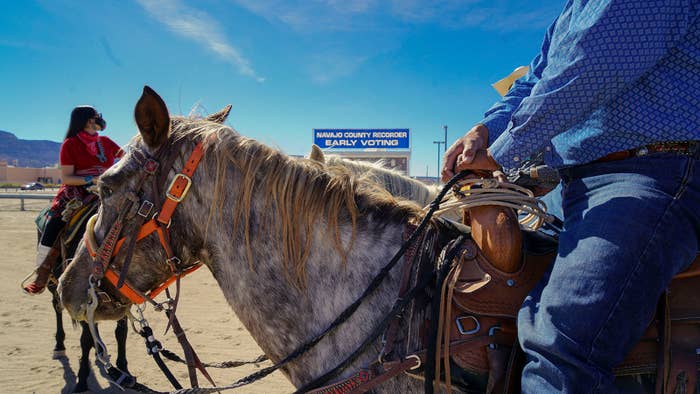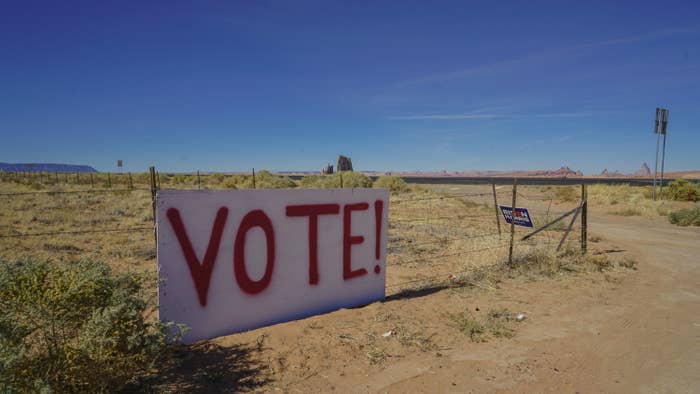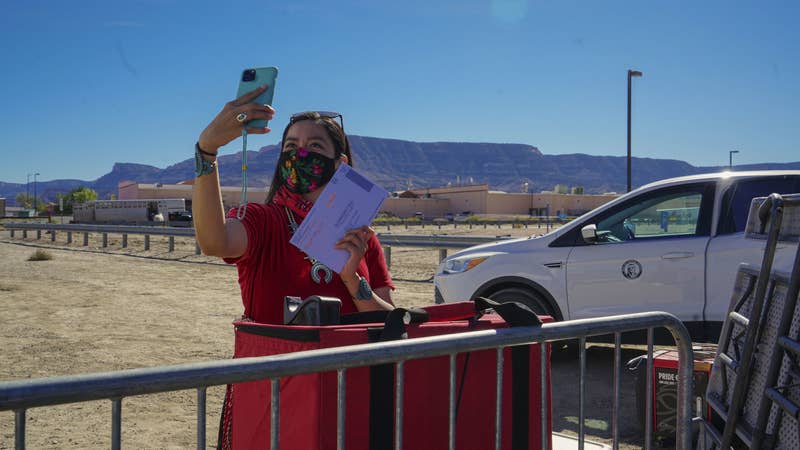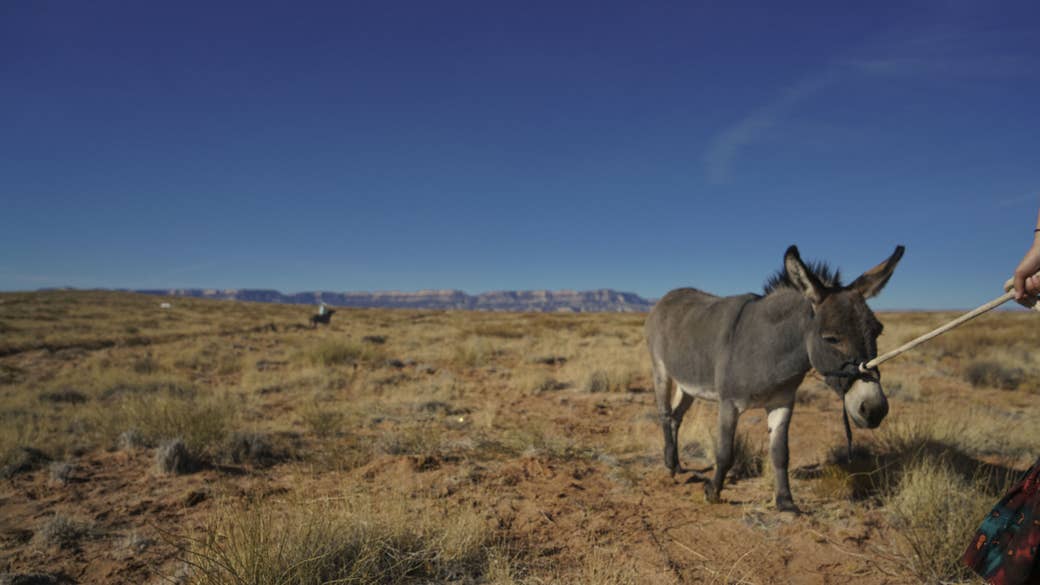IT STARTED AT STANDING ROCK
Native American Voters In Arizona Showed Up In Force For Biden As COVID-19 Ravaged Tribal Nations“This is us saying: COVID-19 is a monster that has come into our communities and devastated our people, but we’re still going to show up,” one citizen of the Navajo Nation told BuzzFeed News.
Clarissa-Jan Lim
BuzzFeed News Reporter
Posted on November 13, 2020

Talia Mayden / HUMAN
Native Americans go to vote by horseback at the Navajo County early voting location.
This has been a catastrophic year for the Navajo Nation. The coronavirus pandemic has spread like wildfire through the sprawling reservation, infecting thousands and killing hundreds. Still, Diné, the Navajo people, voted in huge numbers this election, and largely in favor of Joe Biden, helping turn Arizona, a longtime deep red state, blue.
For Allie Young, a 30-year-old activist and citizen of the Navajo Nation, it's been emotional to watch her community vote in force despite these challenges.
“I feel the only word that comes to mind is proud,” she told BuzzFeed News. “Thinking about the pandemic and how we’ve been impacted because of the decisions from our elected officials — it feels like we put our foot down and we’re saying, ‘We’re gonna be involved in these conversations; we’re going to make sure that we have a seat at the table and that we’re represented.’”
Young, who cofounded Protect the Sacred, a Navajo youth advocacy group, had worked hard to get out the vote in her community. In the weeks leading up to Election Day, she organized several “Ride to the Polls” events to encourage her fellow Diné to go to polling stations on horseback and vote. She was heartened to see dozens of riders join her voting campaign; she was even more appreciative that they were participating in an election that would determine the future of the country in the midst of a pandemic that has ravaged not just her family — her uncle had COVID-19, and several extended family members have died from the virus — but also her people.
“This is us saying: COVID-19 is a monster that has come into our communities and devastated our people — but we’re still going to show up, and it’s not going to get the best of us,” she said.
Across Arizona, there have been nearly 270,000 COVID-19 cases and more than 6,200 deaths to date. And Navajo Nation, the biggest Native American reservation in the US, which spans three states — although the majority of its land sits within Arizona’s borders — has seen more than 12,000 COVID-19 cases and 596 deaths.
Despite the tribal government imposing some of the country’s strictest safety precautions, the Navajo Nation had a higher infection rate per capita than any state in the US in May, including New York, which at the time was the epicenter of the pandemic. Doctors Without Borders, an international organization that sends medical aid to parts of the world stricken by war, famine, and natural disasters, even dispatched a team to the Navajo Nation to help with the crisis.
Now, six months later, the reservation is entering its second wave of the pandemic. Navajo health officials are preparing for “uncontrolled community spread” of the virus, Navajo President Jonathan Nez and the Navajo Health Department’s Jill Jim told local news outlet KOAT on election week.
Indian Country as a whole has been hit especially hard by the virus. Served by a chronically underfunded Indian Health Service, a federal agency within the Department of Health and Human Services, tribal governments had to fight to obtain sorely needed COVID-19 funding relief that the Trump administration delayed distributing.
In July, six tribal nations had higher case rates per capita than any US state, according to the UCLA American Indian Studies Center. The virus is especially deadly among older people, a factor that has been particularly destructive considering the role of Native elders as protectors of their cultural knowledge and traditions.

Talia Mayden / HUMAN
A Biden campaign sign is seen near a spraypainted "VOTE!" sign in Arizona.
Many Native American reservations occupy vast, rural swaths of land, and residents often lack access to basic resources like clean water, internet, or reliable transportation. One in three Native Americans live in poverty, and voter turnout among Indigenous voters has historically been lower than that of other racial or ethnic groups, partly due to the burden of casting a ballot.
“If you’re Native [on a reservation], you gotta drive 40 miles, and hopefully the ballot will be there, and hopefully it will reach the secretary of state on time,” said O.J. Semans, an enrolled member of the Rosebud Sioux Tribe in South Dakota and the cofounder of the Native voter advocacy group Four Directions.
People of color across the country have long been disenfranchised at the ballot box, but those issues are “magnified in Indian Country because of the distance, the poverty, the transportation, the roads,” he told BuzzFeed News.
Considering the long-standing barriers that Native American voters have faced at the polls, and the added safety fears due to the pandemic, seeing them turn out, especially in Arizona, is nothing short of remarkable, Semans said.
“I’m really happy with the turnout based upon the inconveniences that Natives had to face in order to participate,” he said.
Even before Election Day, Arizona was inching toward a milestone: By Oct. 30, the last day of early voting in the state, election officials had received 2.3 million ballots. When Decision Desk HQ called Arizona on Wednesday night, more than 3.3 million votes had been processed — a record number for the state, according to the Arizona secretary of state’s election data. The turnout numbers in Arizona were reflected across the country; both Biden and Trump have received more popular votes than any other candidate in history; the president-elect is about 5 million votes ahead of the current president, and his lead is expected to widen as more are tallied.

Talia Mayden / HUMAN
Allie Young takes a selfie just before casting her ballot at the Navajo County early voting-location.
The number of votes processed so far in the three counties where the Navajo Nation is located altogether show that Biden has won by a larger margin than Hillary Clinton did in 2016: He holds a commanding majority of the vote in Apache (more than half of the county is Navajo Nation) and Coconino counties, though Navajo County, where there is a big Mormon population, went to Trump. (The Hopi tribe is also in Apache and Navajo counties.)
It’s not just the Navajo Nation, either. Native Americans are spread out in reservations across Arizona, as well as in metropolitan areas, and the results show that they have overwhelmingly voted for Biden.
According to an ABC15 map of the election results by precinct, tribal communities have made up a formidable base of support for Biden in the state. A majority of the blue spots on the map, besides metropolitan areas like Phoenix and Tucson, are where tribal nations are located: Navajo Nation and the Hopi in the northeast, White Mountain Apache and San Carlos Apache tribes in the east, the Pascua Yaqui Tribe outside Tucson, Tohono O'odham Nation (whose sacred burial ground the Trump administration desecrated and blew up to make way for the president’s border wall) to the south, Yuma County’s Cocopah Indian Tribe and Fort Yuma Quechan Indian Tribe in the southwest, the Hualapai Tribe in the northwest, and the Colorado River Indian Tribes in the wes
Semans also pointed out that the sizable Native American population in Maricopa County — 2.8% of its residents identify as Indigenous, according to census numbers — where Trump has performed better with mail ballots there (though not enough to beat Biden) than he has in other states.
Posted on November 13, 2020

Talia Mayden / HUMAN
Native Americans go to vote by horseback at the Navajo County early voting location.
This has been a catastrophic year for the Navajo Nation. The coronavirus pandemic has spread like wildfire through the sprawling reservation, infecting thousands and killing hundreds. Still, Diné, the Navajo people, voted in huge numbers this election, and largely in favor of Joe Biden, helping turn Arizona, a longtime deep red state, blue.
For Allie Young, a 30-year-old activist and citizen of the Navajo Nation, it's been emotional to watch her community vote in force despite these challenges.
“I feel the only word that comes to mind is proud,” she told BuzzFeed News. “Thinking about the pandemic and how we’ve been impacted because of the decisions from our elected officials — it feels like we put our foot down and we’re saying, ‘We’re gonna be involved in these conversations; we’re going to make sure that we have a seat at the table and that we’re represented.’”
Young, who cofounded Protect the Sacred, a Navajo youth advocacy group, had worked hard to get out the vote in her community. In the weeks leading up to Election Day, she organized several “Ride to the Polls” events to encourage her fellow Diné to go to polling stations on horseback and vote. She was heartened to see dozens of riders join her voting campaign; she was even more appreciative that they were participating in an election that would determine the future of the country in the midst of a pandemic that has ravaged not just her family — her uncle had COVID-19, and several extended family members have died from the virus — but also her people.
“This is us saying: COVID-19 is a monster that has come into our communities and devastated our people — but we’re still going to show up, and it’s not going to get the best of us,” she said.
Across Arizona, there have been nearly 270,000 COVID-19 cases and more than 6,200 deaths to date. And Navajo Nation, the biggest Native American reservation in the US, which spans three states — although the majority of its land sits within Arizona’s borders — has seen more than 12,000 COVID-19 cases and 596 deaths.
Despite the tribal government imposing some of the country’s strictest safety precautions, the Navajo Nation had a higher infection rate per capita than any state in the US in May, including New York, which at the time was the epicenter of the pandemic. Doctors Without Borders, an international organization that sends medical aid to parts of the world stricken by war, famine, and natural disasters, even dispatched a team to the Navajo Nation to help with the crisis.
Now, six months later, the reservation is entering its second wave of the pandemic. Navajo health officials are preparing for “uncontrolled community spread” of the virus, Navajo President Jonathan Nez and the Navajo Health Department’s Jill Jim told local news outlet KOAT on election week.
Indian Country as a whole has been hit especially hard by the virus. Served by a chronically underfunded Indian Health Service, a federal agency within the Department of Health and Human Services, tribal governments had to fight to obtain sorely needed COVID-19 funding relief that the Trump administration delayed distributing.
In July, six tribal nations had higher case rates per capita than any US state, according to the UCLA American Indian Studies Center. The virus is especially deadly among older people, a factor that has been particularly destructive considering the role of Native elders as protectors of their cultural knowledge and traditions.

Talia Mayden / HUMAN
A Biden campaign sign is seen near a spraypainted "VOTE!" sign in Arizona.
Many Native American reservations occupy vast, rural swaths of land, and residents often lack access to basic resources like clean water, internet, or reliable transportation. One in three Native Americans live in poverty, and voter turnout among Indigenous voters has historically been lower than that of other racial or ethnic groups, partly due to the burden of casting a ballot.
“If you’re Native [on a reservation], you gotta drive 40 miles, and hopefully the ballot will be there, and hopefully it will reach the secretary of state on time,” said O.J. Semans, an enrolled member of the Rosebud Sioux Tribe in South Dakota and the cofounder of the Native voter advocacy group Four Directions.
People of color across the country have long been disenfranchised at the ballot box, but those issues are “magnified in Indian Country because of the distance, the poverty, the transportation, the roads,” he told BuzzFeed News.
Considering the long-standing barriers that Native American voters have faced at the polls, and the added safety fears due to the pandemic, seeing them turn out, especially in Arizona, is nothing short of remarkable, Semans said.
“I’m really happy with the turnout based upon the inconveniences that Natives had to face in order to participate,” he said.
Even before Election Day, Arizona was inching toward a milestone: By Oct. 30, the last day of early voting in the state, election officials had received 2.3 million ballots. When Decision Desk HQ called Arizona on Wednesday night, more than 3.3 million votes had been processed — a record number for the state, according to the Arizona secretary of state’s election data. The turnout numbers in Arizona were reflected across the country; both Biden and Trump have received more popular votes than any other candidate in history; the president-elect is about 5 million votes ahead of the current president, and his lead is expected to widen as more are tallied.

Talia Mayden / HUMAN
Allie Young takes a selfie just before casting her ballot at the Navajo County early voting-location.
The number of votes processed so far in the three counties where the Navajo Nation is located altogether show that Biden has won by a larger margin than Hillary Clinton did in 2016: He holds a commanding majority of the vote in Apache (more than half of the county is Navajo Nation) and Coconino counties, though Navajo County, where there is a big Mormon population, went to Trump. (The Hopi tribe is also in Apache and Navajo counties.)
It’s not just the Navajo Nation, either. Native Americans are spread out in reservations across Arizona, as well as in metropolitan areas, and the results show that they have overwhelmingly voted for Biden.
With a lot of talk about Native voting in Arizona. I thought I would share 2 maps. The left is a map showcasing all 22 tribes in the state. The right an updated 2020 voting results maps by precinct. This give you an idea of how Indigenous communities voted in the 2020 election.
According to an ABC15 map of the election results by precinct, tribal communities have made up a formidable base of support for Biden in the state. A majority of the blue spots on the map, besides metropolitan areas like Phoenix and Tucson, are where tribal nations are located: Navajo Nation and the Hopi in the northeast, White Mountain Apache and San Carlos Apache tribes in the east, the Pascua Yaqui Tribe outside Tucson, Tohono O'odham Nation (whose sacred burial ground the Trump administration desecrated and blew up to make way for the president’s border wall) to the south, Yuma County’s Cocopah Indian Tribe and Fort Yuma Quechan Indian Tribe in the southwest, the Hualapai Tribe in the northwest, and the Colorado River Indian Tribes in the wes
Semans also pointed out that the sizable Native American population in Maricopa County — 2.8% of its residents identify as Indigenous, according to census numbers — where Trump has performed better with mail ballots there (though not enough to beat Biden) than he has in other states.
“We have a lot of urban Indians in Maricopa County,” Semans said, pointing to the Indian Health Service office in Phoenix, which oversees programs in Arizona, Nevada, and Utah.
The Native vote, including in the Navajo Nation, is not a monolith; even the Navajo government leaders openly supported different candidates — its president, Jonathan Nez, endorsed Biden, and its vice president, Myron Lizer, endorsed Trump at the Republican National Convention. But Semans said Indian Country tends to lean left despite Democratic candidates historically having ignored and failed Native American voters to their detriment.
“I can tell you that for being the most left out by the Democratic Party, there has been no race more loyal to the Democratic Party,” Semans said. “Throughout Indian Country, they’ve always been Democratic strongholds but completely ignored.”
A lot has been made of Arizona flipping blue in this election. A crucial battleground state, Arizona has long remained just out of reach for Democratic presidential candidates vying for its 11 electoral votes. President Bill Clinton was the last Democratic candidate who won the state during his reelection bid in 1996. "The Grand Canyon State" has since been a reliable stronghold for Republican presidential candidates, including Trump, who beat Hillary Clinton by a 3.5% margin in 2016.
But the state has seen a significant demographic shift in the past few decades, and the population in its cities and surrounding suburban areas has ballooned. Arizona’s Latino population has more than doubled, according to Pew’s numbers; in recent years, grassroots Latino groups, spurred by an opposition to Trump, have built a massive organizing effort to turn out the vote for Biden this year.
Latino voters have been widely and deservedly credited for flipping Arizona blue. But Native American voters in Arizona, which has 22 tribes and the country’s third-highest population of Indigenous people, have also been acknowledged for their role in handing Biden the state.
Young, who is planning a victory horseback ride next week in honor of Biden winning Arizona, said she has never seen Native American voters recognized more by the media and the public than in the past week since the election ended.
“The way that people are thanking Native people [and] the Navajo Nation, which for me is more personal and hits close. It is my home,” she said about voters who lifted Biden to victory in Arizona. “It is emotional for me and my people. We’re always invisible in this country, in our own homelands. So it feels really nice to be acknowledged right now.”
She also wants people to change their notions of who Arizonans are and what they look like — and understand that it’s not just a state where conservative white people go to retire.
“Arizona is filled with so many diverse communities,” she said. “People think Arizona is filled with retired, white conservatives. We’re gonna prove them wrong. We‘re gonna reclaim how we show up to the polls, and we’re gonna reclaim Arizona — because Arizona has Indigenous DNA.” ●

Talia Mayden / HUMAN
A donkey is guided behind a group of Native Americans on horseback on their way to vote.
Clarissa-Jan Lim is a reporter and editor at BuzzFeed News. She is based in New York

No comments:
Post a Comment